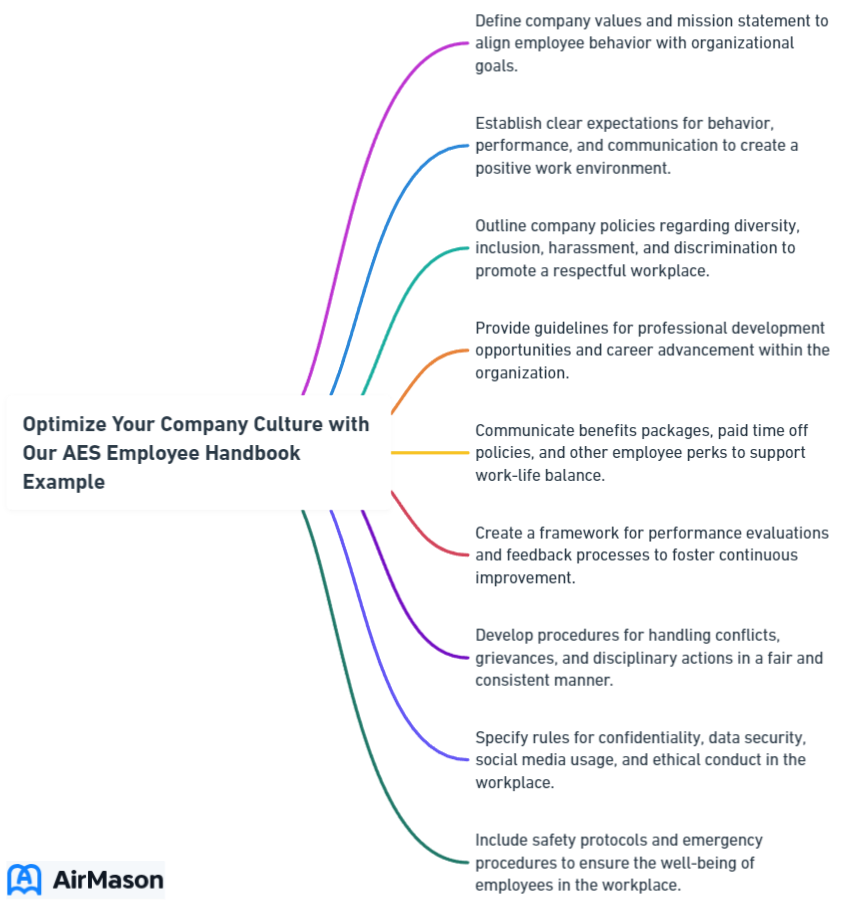
Looking for an aes employee handbook example to guide your own policy creation? Our article breaks down a sample handbook, featuring must-have sections, from company culture articulation to compliance and employee benefits. Gain insights on customizing your handbook and strategies for implementation, ensuring it supports your workforce effectively and upholds your unique organizational values.
Key Takeaways
- An employee handbook serves as a vital reflective tool encapsulating an organization’s mission, culture, policies, and expectations, which requires customization to fit specific company needs and to maintain legal compliance.
- Including comprehensive information on health and safety protocols, harassment and discrimination policies, as well as details on compensation, benefits, and work-life balance supports are crucial to promoting employee well-being and clear expectations.
- To ensure understanding and compliance, the employee handbook should be accessible in different formats, regularly updated, clearly written, and implemented through management enforcement, training sessions, and a culture of feedback and continuous improvement.
Employee Handbook Examples
When searching for comprehensive guidance on crafting your company’s employee handbook, exploring various “employee handbook examples” can be invaluable. These illustrative documents showcase diverse approaches to policies, procedures, and company culture. Examining different “employee handbook examples” can provide valuable insights into structuring content, addressing employee needs, and ensuring legal compliance. By reviewing a range of “employee handbook examples,” organizations can tailor their own handbook to meet specific requirements while fostering a positive and transparent work environment. In essence, these examples serve as practical templates, inspiring companies to create documents that effectively communicate expectations and values to their workforce.
Crafting Your Employee Handbook: A Template for Success
An employee handbook is essentially a mirror reflecting your organization’s mission, culture, and values. It sets expectations and communicates policies that guide behavior in your organization. It’s the tool that tells your employees, “This is how we do things here.”
Crafting a successful employee handbook hinges on defining its purpose, incorporating essential components, and tailoring the content to suit your specific organizational needs.
Defining the Purpose of Your Handbook
Handbooks act as a comprehensive guide encapsulating your company’s mission, vision, and values. Clear definition of its purpose enables healthy management-employee relationships, seamless onboarding processes, and enhanced communication.
Additionally, aligning your handbook with your company’s mission and values draws in employees who share your organization’s goals, creating a transparent framework for employees to grasp and adhere to the company’s mission and values.

Essential Components to Include
A successful employee handbook combines key elements seamlessly. These include:
- Your company’s culture
- Policies
- Legal requirements
- Onboarding and joining instructions
- Code of conduct
- Notice and disclaimer/acknowledgement of receipt
- Clear job descriptions and expectations
Moreover, it should provide guidance on how employees can address complaints or raise concerns about personnel or job conditions.
Customizing Content for Your Organization
A one-size-fits-all employee handbook does not exist. Customizing your handbook to encapsulate your company’s distinct policies, benefits, and culture is vital. Be it benefits, code of conduct, or leave policies, each section needs to mirror your company-specific procedures. Moreover, the legal disclaimers should be customized to prominently state that the handbook does not create a contract and highlight the at-will nature of employment.
Health and Safety Protocols

Health and Safety Protocols are a critical aspect of any employee handbook, with sections dedicated to workplace safety measures, health insurance options, and addressing harassment and discrimination. These sections inform employees about their rights and responsibilities concerning their health and safety and the procedures to follow when these rights are violated.
Workplace Safety Measures
Workplace safety isn’t just about avoiding physical injuries; it also encompasses maintaining a safe and healthy work environment. Your handbook should clearly define workplace hazards, methods for ensuring employee compliance with safety measures, and how health and safety training is incorporated. This way, employees understand their role in maintaining a safe workplace.
Amphenol Employee Handbook Example
In this illustrative Amphenol Employee Handbook Example, we delve into the comprehensive guidelines and policies that govern the conduct and expectations within the organization. The Amphenol Employee Handbook serves as a foundational document, outlining the principles and standards that define the workplace culture. Employees are encouraged to familiarize themselves with this handbook, as it provides valuable insights into the company’s values, code of conduct, and various operational procedures. As part of Amphenol’s commitment to fostering a positive and inclusive work environment, the handbook serves as a reference point for both new hires and existing employees to navigate their roles with clarity and integrity.
Health Insurance Options
Health insurance is an integral part of the employee benefits package. The employee handbook should clearly outline the health insurance options provided by the company, the coverage offered, and how employees can avail of these benefits.
Effective communication of these details helps employees better understand and utilize their health benefits.
Addressing Harassment and Discrimination
Maintaining an environment free from harassment and discrimination is not just a legal requirement; it’s a moral obligation. Your handbook should include the following:
- A clear definition of what constitutes harassment and discrimination
- The procedures for reporting such incidents
- The actions the company will take in response
This not only protects your employees, but it also fosters an inclusive and respectful workplace culture.
Compensation and Benefits Breakdown

The compensation and benefits section of your employee handbook should detail the following:
- Salary structures
- Payment schedules
- Retirement plans
- Financial perks
- Leave policies
This section serves as a transparent disclosure of what employees can expect in return for their work at the table.
Clear communication of these components allows employees to understand the full value of their employment package.
Salary Structures and Payment Schedules
Transparency in salary structures and payment schedules is crucial in maintaining trust and satisfaction among employees. Your handbook should explain the process of determining salary structures and the payment frequency. This helps to manage employees’ expectations and ensure they understand their compensation plan.
Retirement Plans and Financial Perks
Retirement plans and financial perks significantly contribute to employee satisfaction and retention. Clearly outlining these details in the employee handbook provides a comprehensive view of the financial benefits that come with working for your company. This not only helps attract talent but also fosters a sense of security among your employees.
Leave Policies and Work-Life Balance
Encouraging work-life balance is key to employee wellbeing and productivity. Your handbook should encompass policies related to:
- vacation
- sick leave
- parental leave
- other forms of leave
It should also highlight your company’s commitment to supporting work-life balance.
This reinforces your company’s commitment to employee wellbeing.
Navigating the Employment Lifecycle

Your employee handbook serves as a companion to your employees at every stage of their journey in your company, from onboarding to exit. It should deliver explicit guidelines for each phase of the employment lifecycle, such as onboarding, growth and development opportunities, and exit procedures.
This ensures a consistent and effective approach to managing employees throughout their tenure.
Onboarding and Integration
The onboarding process sets the tone for an employee’s entire journey. A well-structured onboarding program in the handbook helps to facilitate a smooth transition into the company, fostering a positive first impression.
It’s about setting clear expectations, providing necessary resources, and fostering relationships.
Growth and Development Opportunities
Employees value growth and development opportunities. This section should outline the paths available for career progression and the support provided by the company for continuous learning and development.
This not only motivates employees to enhance their skills but also cultivates a culture of learning within the organization.
Exit Procedures
The exit process is just as crucial as the onboarding process. Your handbook should provide clear guidelines on what employees and the company should do when an employee decides to leave. This ensures a smooth transition and maintains a positive relationship with former employees.
Legalities and Acknowledgment

An employee handbook should also offer explicit instructions on legal and compliance matters. These should encompass sections ensuring legal compliance, safeguarding intellectual property, and documenting the receipt and acknowledgment of the handbook.
This helps to avoid potential legal pitfalls and ensures that employees understand their obligations.
Ensuring Legal Compliance
Your employee handbook serves as a critical legal document. As such, it should comply with all relevant employment laws and regulations. This includes provisions for minimum wage, anti-discrimination policies, and safety and health regulations, among others. Breaking these laws can lead to serious legal consequences, so it’s crucial to ensure your handbook is legally sound.
Intellectual Property and Confidentiality Agreements
Protecting your company’s intellectual property and maintaining confidentiality are crucial to your business. The handbook should include clear guidelines on how employees should handle intellectual property and confidential information.
This not only safeguards your company’s assets but also sets clear expectations for the company’s employees.
Receipt and Acknowledgment Section
The receipt and acknowledgment section serves as proof that employees have received, understood, and agreed to the policies outlined in the handbook. It’s a critical component that helps protect your company in the event of a dispute.
Make sure that every employee signs this section and understands its significance.
Enhancing Accessibility and Understanding
The effectiveness of your handbook depends on how well your employees can access and understand it. This section will cover strategies to enhance the language and readability of your handbook, the benefits of providing it in both digital and physical formats, and the importance of regular updates and communication.
Mutual of Omaha Employee Handbook Example
At Mutual of Omaha, the Employee Handbook serves as a comprehensive guide outlining our organizational policies and expectations. The Mutual of Omaha Employee Handbook Example provides a clear and detailed illustration of our commitment to fostering a positive work environment. Employees can refer to this handbook to gain insights into company values, code of conduct, and essential HR policies. By adhering to the guidelines outlined in the Mutual of Omaha Employee Handbook Example, we ensure a harmonious workplace where everyone understands their roles and responsibilities. It serves as a valuable resource for both new hires and seasoned employees, promoting a culture of transparency and mutual understanding within the organization.
Language and Readability
The language and readability of your handbook significantly influence your employees’ comprehension. It’s vital to use simple and straightforward language, steering clear of jargon and complicated terms. This ensures that your employees can easily comprehend and adhere to your company’s policies and procedures.
Digital and Physical Formats
Providing the handbook in both digital and physical formats ensures that it’s accessible to all employees, regardless of their preference. A digital version allows for easy updates and access, while a physical copy can be a handy reference tool.
Both formats should be easy to navigate and reflect the company’s branding, ensuring an equal user experience.
Regular Updates and Communication
Regular updates and communication keep your employee handbook relevant and in line with current policies, procedures, and regulations. Regular reviews and updates ensure that the handbook is always up to date and reflects any changes in the company’s policies or procedures.
Effective communication of these updates helps employees stay informed and compliant.
Implementing Effective Use of the Handbook
The effectiveness of your handbook lies in its implementation. This section will cover strategies to ensure that your handbook is not just a document, but a tool that guides your employees in their everyday work. This includes training sessions and workshops, the role of management in enforcement, and the importance of feedback and continuous improvement.
Training Sessions and Workshops
Training sessions and workshops serve as platforms to introduce the handbook to new employees and revisit it for existing ones. These sessions enable a detailed walkthrough of the handbook, an opportunity to answer queries, and ensure a comprehensive understanding of the policies and procedures.
This helps to ensure that the handbook is not just a document, but a tool that guides everyday work.
Role of Management in Enforcement
Managers have a vital role in implementing the policies detailed in the handbook. They should receive training on the policies and hold responsibility for their enforcement among their team members. This ensures that the policies are consistently applied across the organization, fostering a culture of compliance.
Feedback and Continuous Improvement
Feedback and continuous improvement are key to maintaining the relevance and effectiveness of your handbook. Employees should be encouraged to provide feedback on the handbook, which can be used to make necessary enhancements.
Regular updates based on feedback and continuous improvement methods ensure that your handbook evolves with your company and its employees.
Summary
In conclusion, an employee handbook is more than a document; it’s a tool that shapes your company’s culture and guides your employees’ behavior. From defining the purpose of your handbook to implementing effective usage, every step is crucial in crafting a successful employee handbook. By focusing on accessibility, regular updates, and continuous improvement, your handbook can serve as a valuable resource for your employees and contribute to your company’s success.
Frequently Asked Questions
How do I do a simple employee handbook?
To create a simple employee handbook, include key sections such as introduction and welcome, workplace commitments, company policies and procedures, employment classification, attendance policies, leave policies, work performance, and discipline policy. This will provide a comprehensive guide for your employees.
What is employee handbook template?
An employee handbook template is a document that contains HR policies, procedures, and guidelines for employees, covering topics such as workplace policies, code of conduct, compensation, and termination procedures. It serves as a valuable resource for outlining how the workplace functions for employees.
What are the key components of the associate handbook?
The key components of an associate handbook include organizational information, compensation and benefits, code of conduct, leave of absence policies, equal employment and non-discrimination policies, workplace safety, and other applicable policies. These elements are crucial for providing comprehensive guidelines for employees.
Is AES a good company?
Based on over 925 employee reviews, AES Corporation has an overall rating of 4.3 out of 5, with 87% of employees recommending it as a good company to work for and 86% expressing a positive outlook for the business. Therefore, AES Corporation is considered a good company to work for.
What is the primary objective of an employee handbook?
The primary objective of an employee handbook is to communicate company policies, expectations, culture, and consolidate all company policies in one place. It also elaborates on the company’s mission, vision, and values.
Important Disclaimer:
The article presented here does not serve as a representation of the company’s actual employee handbook mentioned in this article.
Our discussions and insights regarding employee handbook are based on assumptions about what may be considered significant in the companies’ policies. These assumptions are drawn from available information and industry knowledge. Readers are advised that the content provided is for informational purposes only and should not be construed as an exact reflection of any company’s official policies or procedures. For precise and accurate details regarding a company’s employee handbook, individuals should refer directly to the company’s official documentation or consult with appropriate representatives.
Please be aware that the content on this page has been generated by using artificial intelligence language models and may contain errors, inconsistencies, or outdated information. It is provided as-is without any warranties or guarantees of accuracy. We strongly recommend using this content as a starting point for further research. We disclaim any liability for damages or losses resulting from the use or reliance on this content.